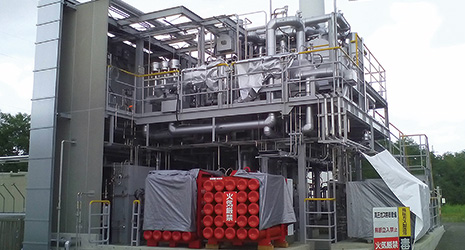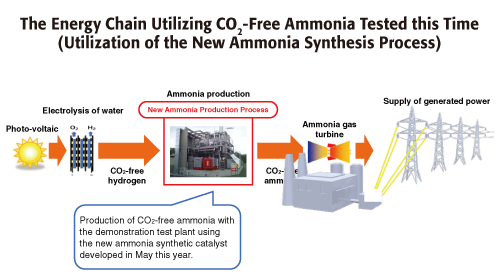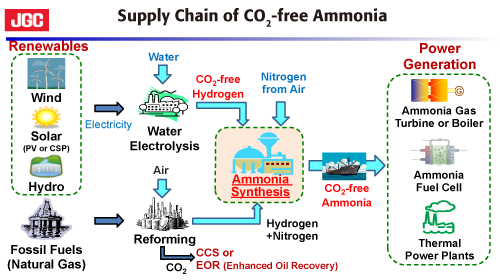Home > Highlighting JAPAN > Highlighting Japan July 2019 > Science & Technology
Highlighting JAPAN


A New Energy Society that Uses CO2-free Ammonia
In October 2018, a Japanese research group announced their success in the world’s first gas turbine power generation experiment fueled by CO2-free ammonia from manufacturing to power generation. This method is expected to be the first step toward constructing a CO2-free energy supply chain.
In recent years, ammonia has attracted attention as a future energy source that can replace fossil fuels. Ammonia can be transported in massive quantities, and the significant reason for this is that ammonia does not generate CO2 when it burns. In 2018, a Japanese research group succeeded for the first time in the world in synthesizing ammonia (renewable energy-synthesized ammonia) from hydrogen manufactured by using renewable energy (renewable energy-synthesized hydrogen) and in generating power fueled by that ammonia under the “Energy Carriers” technology development program, a part of the Cabinet Office’s Cross Ministerial Strategic Innovation Promotion Program (SIP).
Yasushi Fujimura, Chief Engineer of JGC Corporation’s R&D Center, has played a central role in this research and development.
Fujimura says, “It is currently said that around 40% of CO2 emissions in Japan are from thermal power plants that burn fossil fuels, and how to reduce these emissions is a social challenge. People now have great expectations for hydrogen as a clean energy source that can replace fossil fuels. However, hydrogen is extremely difficult to transport and store. In response to this situation, we invented a method of manufacturing renewable energy-based hydrogen by electricity generated by solar and wind power, of synthesizing renewable energy-based ammonia that is easy to transport and store from hydrogen, and of generating power fueled by the hydrogen.”
Ammonia has been produced for industrial purposes, such as for fertilizers and for manufacturing synthetic fibers, for more than 100 years. Means of transporting and storing ammonia were established, and it can be carried safely by tanker and tank truck. But because hydrogen, the raw material, is made with natural gas in the current process, CO2 is inevitably produced in the stage of manufacturing ammonia.
According to Fujimura, the key to synthesizing ammonia using renewable energy-based CO2-free hydrogen was the development of a new catalyst.
Fujimura says, “Originally, we used high-temperature, high-pressure hydrogen made using natural gas in synthesizing ammonia. But because we need another form of energy to convert hydrogen created by solar and wind power into a high-temperature, high-pressure state, CO2 will inevitably be produced during that process. This is why we took four years to develop a catalyst using an element called ruthenium and developed techniques for synthesizing ammonia efficiently, even in a low-temperature, low-pressure state.”
In addition, during approximately the same period, another research group of the SIP “Energy Carrier” was developing a new technology for burning ammonia to generate power in a clean manner. By combining these two new techniques, in August 2018, the Fukushima Renewable Energy Institute, AIST (FREA) succeeded in synthesizing ammonia using CO2-free hydrogen and gas turbine power generation fueled by that ammonia.
This success shows a steady step forward toward realizing a low-carbon hydrogen society in which people generate power in a land with a rich pool of solar and wind power energy, transport renewable energy-based ammonia synthesized from that power in safety to thermal power plants in suburban areas and use the electricity generated by this fuel. This research result is incorporated into the framework of the government-driven Society 5.01 as an important means of constructing a new energy value chain and an advanced low-carbon smart community.
With growing interest in foreign countries, joint investigation and research projects for constructing a CO2-free ammonia supply chain are already under way. We will also pay careful attention to cooperation in international practical applications from now on.


Note:
1 Society 5.0 is the society that is committed to realizing innovations that boost productivity dramatically, such as artificial intelligence (AI), robots and Internet of Things (IoT), with the realization of the productivity revolution.
© 2009 Cabinet Office, Government of Japan






